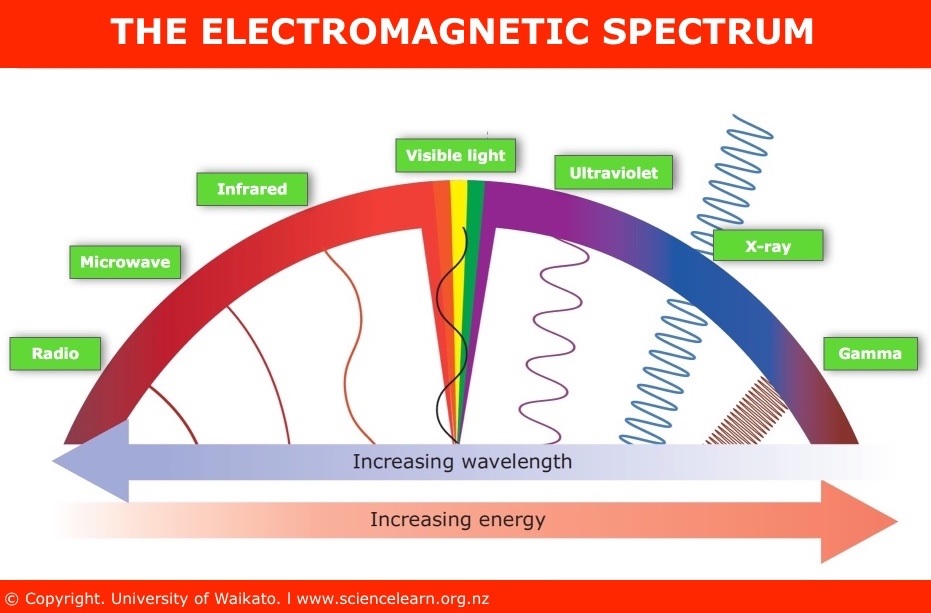In this week’s parasha, Shemot, God first reveals Himself to Moses. He introduces Himself thus: “I am the God of your forefathers; the God of Abraham, the God of Isaac, and the God of Jacob.” (Exodus 3:6) Later on in the conversation, Moses asks God how he should tell the Children of Israel about God, and what name should he use in referring to God? God replies that He is Ehyeh Asher Ehyeh, “I will be what I will be”. The simple meaning here is that God is trying to convey that He is not some idol or pagan deity. He has no shape or form; he has no location. He is everywhere and imbues everything. He is everything. He will be whatever He needs to be; wherever, whenever. Only after that introduction, God says:
Thus shall you say to the children of Israel: YHWH, the God of your fathers; the God of Abraham, the God of Isaac, and the God of Jacob, has sent me to you; this is My name for ever, and this is My memorial unto all generations. (Exodus 3:15)
God reveals His eternal name: YHWH (יהוה), a term so holy and powerful it is not uttered. It is referred to as God’s “Ineffable” Name, or just the Tetragrammaton (literally the “four-letter” name), and by Jews as Hashem (“The Name”), or Adonai (“My Lord”) in prayers or Torah readings. Some Jews refer to it by rearranging the letters and saying Havaya. (Some non-Jews have transliterated it into English as “Jehovah”.) Whatever the appellation, this name of God carries infinite depths of meaning. Several of these will be explored below.
God in All Dimensions
Last week, we discussed how Hashem is a fusion of haya, hov’e, ihyeh, “was, is, and will be”. God is the eternal force that exist across time—past, present, and future—simultaneously. We also saw last week how God’s Name “squared” mathematically represents that He imbues every inch of the universe’s space. God is everywhere. This is further alluded to in the letters of the Tetragrammaton:
 Jewish mysticism describes the universe as existing in four dimensions or “worlds”, olamot. The lowest, which we inhabit, is called Asiyah, the world of “action”. Above that is Yetzirah, “formation”. Further still is Beriah, “creation”, and the highest is Atzilut, “emanation”. There is also a hidden, fifth dimension which stands apart from the others, called Adam Kadmon, “primordial man”. When the Torah says that God made Adam in “His image”, it is secretly alluding to Adam Kadmon, God’s initial burst of light that filled the universe at the very start of Creation. Adam Kadmon is related to that luminous “image” of God. The human Adam was only a small copy, a partial reflection of sorts, of that primordial “image”. Interestingly, it has been pointed out that when spelled vertically, the Tetragrammaton actually forms a rough “image” of a human!
Jewish mysticism describes the universe as existing in four dimensions or “worlds”, olamot. The lowest, which we inhabit, is called Asiyah, the world of “action”. Above that is Yetzirah, “formation”. Further still is Beriah, “creation”, and the highest is Atzilut, “emanation”. There is also a hidden, fifth dimension which stands apart from the others, called Adam Kadmon, “primordial man”. When the Torah says that God made Adam in “His image”, it is secretly alluding to Adam Kadmon, God’s initial burst of light that filled the universe at the very start of Creation. Adam Kadmon is related to that luminous “image” of God. The human Adam was only a small copy, a partial reflection of sorts, of that primordial “image”. Interestingly, it has been pointed out that when spelled vertically, the Tetragrammaton actually forms a rough “image” of a human!
The four universes are alluded to in the four letters of God’s Name: the final hei corresponds to Asiyah, the vav to Yetzirah, the first hei to Beriah, and the yud to Atzilut. The “crown” on top of the yud corresponds to that most sublime aspect of Adam Kadmon. These universes themselves correspond to the mystical Sefirot, which are also represented by the Tetragrammaton: the final hei is the lowest Sefirah of Malkhut. The vav (which has a value of six) represents the vav ketzavot, the six Sefirot above Malkhut corresponding to the six directions of our three-dimensional reality. The first hei is Binah, the yud is Chokhmah, and the crown atop the yud is Keter, literally the “crown” of the Sefirot.
Finally, the universes and Sefirot both parallel the levels of human soul (explained in detail here). The lowest level of soul is the nefesh, the basic life force that flows through the blood. It is followed by ruach in the vital organs, and then the neshamah, sitting in the brain. The higher levels of soul are chayah, associated with the aura, and yechidah, a “divine umbilicus” connecting a person directly to the Heavens. These, too, correspond to the parts of God’s Name, in order. To summarize:
This is meant to teach us that God also imbues all levels of our own soul, which takes us back to the notion of Adam Kadmon, the universal “primordial man”. Kabbalistic texts speak of a human as an olam katan, a “small universe”, and the universe as an adam gadol, a “great man”. Each human soul is a microcosm of the universe, and the universe is a macrocosm of a human soul. It may help explain the strange “coincidence” where the universe actually looks like the human brain, baffling scientists. A typical brain has about 100 billion neurons, and the universe is estimated to have 100 billion galaxies. Like neurons, galaxies appear to be interconnected in a great cosmic “web”. Both the brain and the universe are composed of three-quarters of “passive” material: the brain filled with water, and the universe with dark energy. Their visual similarities are striking.
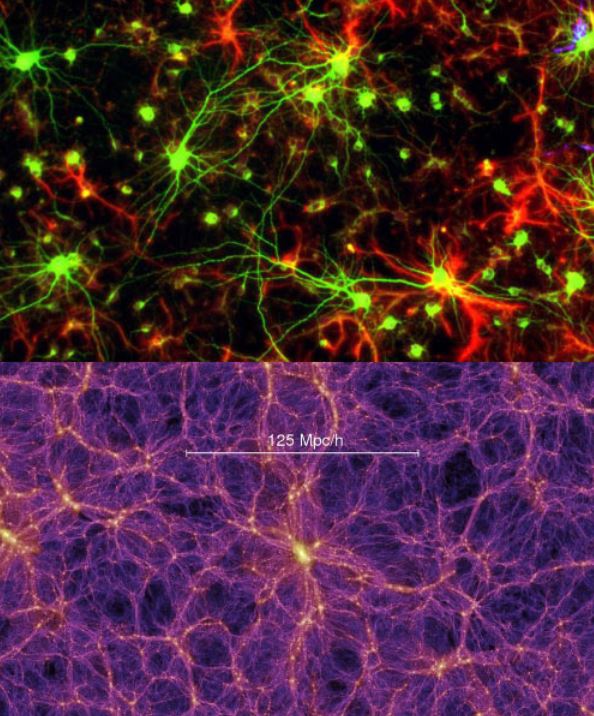
Top: a section of interconnected neurons from the brain. Bottom: a section of the universe showing the “cosmic web” of galaxies. (Credit: SciNews)
God in Biology and Physics
If God imbues every iota of the universe, we would expect to find Him in its four fundamental forces. The four basic forces of nature that make our universe work are: gravity, electromagnetism, and the strong and weak nuclear forces. We can neatly relate them to the four letters of God’s Name. The two letters hei correspond to those two nuclear forces. The straight letter vav, described by our Sages as a ray of light, fittingly alludes to the electromagnetic force which includes within it the spectrum of light and radiation. (The six major forms of radiation—radio waves, microwaves, infrared, ultraviolet, X-rays, and gamma rays—are further alluded to by vav having a value of six.)
Finally, the yud, alone among letters to be suspended “up in the air”, as if about to fall down, reminds us of gravity. (Earth’s gravity happens to be just about 10 m/s2, the value of yud.) Today, scientists are in search of the “grand unified theory” (the GUT), which can integrate and explain all four of the fundamental forces (the leading candidate is currently string theory). The GUT would correspond to that sublime fifth aspect of God’s Name, the crown of the yud.
In our bodies, too, we can find the Tetragrammaton. The very code that makes us who we are (at least, physically) is DNA. Like any code, it is composed of an “alphabet”. Long ago, biologists thought that the genetic code must be made up of amino acids, of which there are at least 20. This would give enough variation to generate all the different traits we see in biology, across millions of species. However, scientists soon discovered that the code was actually made up of nitrogen bases—and just four of them! The four bases are adenine, cytosine, guanine, and thymine: A, C, G, and T.
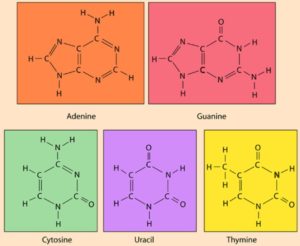 Now, DNA is so important that our cells don’t want to risk damaging it in the hostile environment of the cell. The DNA is kept locked up inside the nucleus. To actually convert the code into proteins, it is “transcribed” into a messenger molecule, RNA, which goes out to the cell’s cytoplasm so that proteins can be made and you can exist. (RNA is currently in the spotlight thanks to the new coronavirus vaccines that use messenger RNA biotechnology.) RNA uses the same bases as DNA, except that instead of thymine there is a fifth nitrogen base, the small uracil. As you guessed, that would nicely correspond to the crown of the yud!
Now, DNA is so important that our cells don’t want to risk damaging it in the hostile environment of the cell. The DNA is kept locked up inside the nucleus. To actually convert the code into proteins, it is “transcribed” into a messenger molecule, RNA, which goes out to the cell’s cytoplasm so that proteins can be made and you can exist. (RNA is currently in the spotlight thanks to the new coronavirus vaccines that use messenger RNA biotechnology.) RNA uses the same bases as DNA, except that instead of thymine there is a fifth nitrogen base, the small uracil. As you guessed, that would nicely correspond to the crown of the yud!
Finally, all matter, including our DNA, is made up of fundamental particles. There are four fundamental particles of matter (or fermions) that make up everything: the up and down quarks, electrons, and neutrinos. The two quarks correspond nicely to the two heis of God’s Name, the vav to the electron, and the tiny neutrino to the tiny yud. Aside from these, there are a number of inconspicuous “force carriers”, or bosons, which would correspond to the crown of the yud.
Most intriguingly, scientists have found that there are two sets of permutations of those fundamental fermion particles. Altogether then, there are actually twelve fundamental particles of matter. Incredibly, Kabbalah has long spoken of the twelve permutations of God’s Name, since the four letters can be rearranged in twelve ways. These correspond to the twelve months of the year and the twelve Zodiac signs, as well as the twelve Tribes of Israel. (Each month itself has four weeks, further corresponding to the four letters of God’s Name, as taught by the Lubavitcher Rebbe. See Likkutei Sichos, Vol. III, pg. 158)
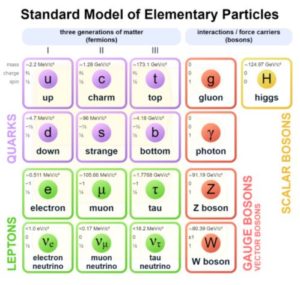
The twelve particles on the left make up the universe’s matter. The first column of four can account for pretty much most of the universe. The other two columns are just variations of the first column.
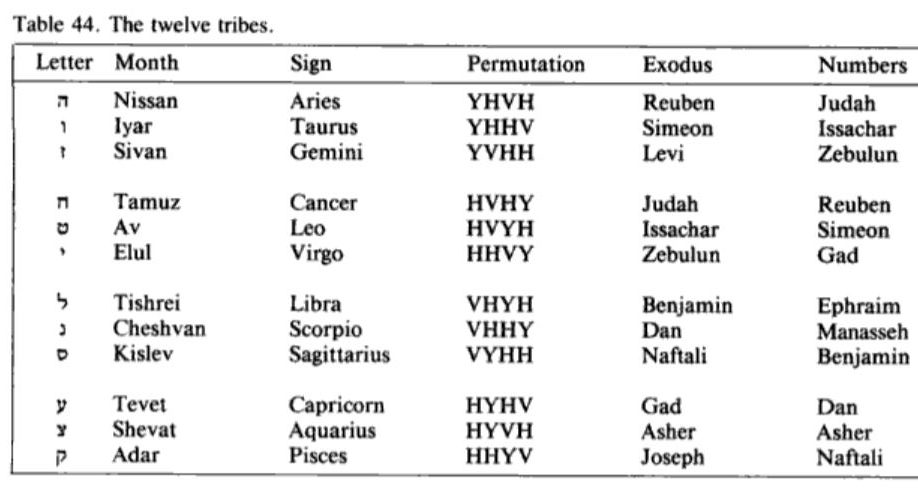
The twelve permutations of God’s Name, as they correspond to the twelve months, Zodiac signs, and Tribes of Israel. (From Rabbi Aryeh Kaplan’s Sefer Yetzirah, pg. 198)
God of Love
We find in the Torah that God is frequently described as being El Kanah, a “jealous” or “passionate” God. In one place (Exodus 34:14), it even states ki YHWH kanah shmo—which can literally be read as “His name YHWH is Jealous” or that “His name YHWH means jealousy”. Based on this, the renowned scholar Shelomo Dov Goitein (1900-1985, who was a close friend of Gershom Scholem, and made aliyah with him) proposed that God’s Name literally means “jealousy”, “passion”, or “love”. Goitein was one of the world’s top experts on the history and culture of Arabia and Islam (as well as the Cairo Geniza of ancient Jewish documents). He pointed out that in Arabic, the word for “love” or “passion” is hawaya. It has the same root letters as the Tetragrammaton. Now, Arabic is also a Semitic language, and is rooted in Hebrew. Indeed, the word for love in Hebrew is ahava, which is very closely related to hawaya. (Interestingly, the Hebrew verb lehov may be the root of the English “love”!)
We must remember that the people and language of Arabia came from our forefather Abraham, too, through his sons Ishmael and Midian. The Torah tells us that Abraham gave various spiritual “gifts” and teachings to his other children before sending them away from the Land of Israel, which remained an inheritance solely for Isaac (Genesis 25:6). Ishmael and Midian settled in the region of Paran, southeast of the Holy Land. God originally came “down to Earth” and revealed Himself there, in the Paran wilderness, on Mt. Sinai, as it is written: “YHWH came from Sinai… appearing from Mt. Paran” (Deuteronomy 33:2).
In light of all this, the suggestion that the Tetragrammaton also has the connotation of “God of Love” is a good one. After all, the theme of love between God and His people is one of the Tanakh’s greatest and most frequent. This is overtly revealed in Shir HaShirim, the “Song of Songs”, which is traditionally taken to be a metaphor for the passionate love between God and Israel. Rabbi Akiva famously called it the holiest part of Scripture. We recall God’s love for us in the blessings before Shema, morning and night, and the first command within the Shema itself is for us “to love YHWH, your God”. More than anything, Judaism reminds us that God loves us, and we are to love Him.
Of course, love is only wholesome and complete between two individuals when it goes both ways. The value of “love” (אהבה) is 13, so when love does go both ways we get 26, the value of יהוה! While we’ve seen how God can be found across dimensions of time and space, in alternate universes, in our very biology and the forces and particles of the cosmos, the most easily-perceptible place where God can be found is in any truly loving relationship.
Shabbat Shalom!



